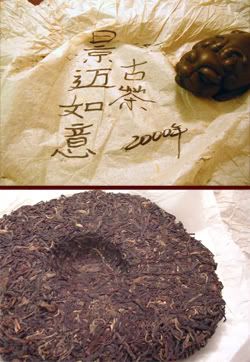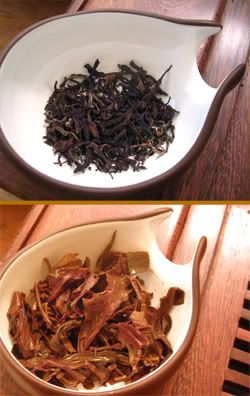This is a bing obtained remotely, ordered by 'phone, in which we took a chance on a vendor (in Sichuan) who has provided us with good tea in the past when we ordered from him in person. We specified the general parameters of what we were after: good tea, with 5-10 years of aging, avoiding the usual big-brand factories such as Menghai and Xiaguan. Our thinking ran: if he replies with interesting tea, then perhaps we'll order again; if he replies with something flagrantly unpleasant, then we'll consign him to the history books.
The jury is still deciding which of those two outcomes has occurred. Let's examine the facts.
 The tea is from the Jingmai region, with "Ruyi" referring to "As You Like It", or thereabouts. It's wrapped in a hand-written light paper. The vendor regarded this as unusually good, saying that it was a "special order". The wrapper claims to be "gu cha" [ancient tea], and is marked 2000 - as you can see. I take all this with a pinch of salt, of course.
The tea is from the Jingmai region, with "Ruyi" referring to "As You Like It", or thereabouts. It's wrapped in a hand-written light paper. The vendor regarded this as unusually good, saying that it was a "special order". The wrapper claims to be "gu cha" [ancient tea], and is marked 2000 - as you can see. I take all this with a pinch of salt, of course.~15cl Caledonian Springs in 35cl shengpu pot; ~5g of leaf; 1 rinse
Dry leaves:
This cake is very loosely compressed; there is almost nothing holding it together except goodwill. This makes it easy to separate into individual leaves without damage and, perhaps, aids the aging process. They are dark, long, and very fruity - this smells... well, it smells of hongcha. "Alarm bells are ringing, Winston."
15s, 10s, 15s:
Medium orange soup, which is very clean. A light aroma, of mild, earthy scents. Not unlike... hongcha. The feeling on the tongue is particularly delicious - it is smooth, and coats the tongue well. There is a distinct hongcha-esque sourness and tartness in the huigan and aftertaste.
 Later infusions give the floral, leathery scents of hongcha in the wenxiangbei. It is fresh, and feels quite effervescent in the mouth. For some reason, it fits rather well with Purcell's "Dido and Aeneas", which matches my semi-Baroque tastes. Apparently Purcell only lived 36 years, which explains the lack of output. This tea is similarly baroque, being intricate and dark - perhaps a little too fussy.
Later infusions give the floral, leathery scents of hongcha in the wenxiangbei. It is fresh, and feels quite effervescent in the mouth. For some reason, it fits rather well with Purcell's "Dido and Aeneas", which matches my semi-Baroque tastes. Apparently Purcell only lived 36 years, which explains the lack of output. This tea is similarly baroque, being intricate and dark - perhaps a little too fussy.Used leaves:
Big and red. They do look pleasant, as you can see for yourself. All sizes are represented, from tips to 4cm main-branch leaves. Note the redness.
Overall:
If it looks like hongcha, smells like hongcha, and tastes like hongcha... then it's hongcha. The leaves don't appear (in structure) to be what one would associate with hongcha, but even the bing itself gives the game away. It is big, smooth and pleasant in a way that hongcha tends not to be, particularly the Dianhong that originates from Yunnan. It could be that it has just been allowed to oxidise sufficiently to give it that hongcha character.
Judging the tea on its own merits, it is good - fine feeling, good patience, enjoyable surrounding flavours. This gives the jury some hesitancy in their decision, but the decision is inevitable: this isn't very much like pu'er, and suspicion rests on the vendor - not a good sign for his future chances of getting custom from us.
I shall list it under "shengpu" in the Index - but its shengpu status is far from certain.

8 comments:
There are, supposedly, some cakes that were made with inadequate kill-green, thus it basically oxidizes like a hongcha... or hongcha-esque.
Hi, LZ,
It's a fascinating cake. The inadequate kill-green process sprung to mind when transcribing these notes - I was reminded of reading your description of the 2001 Menghai Yiwu and the Fuhai.
They're good leaves in this cake. They're just... interestingly malty and leather-tasting. The overall effect is pleasant.
I haven't come to a conclusion on the integrity of the supplier, however. ;)
Toodlepip,
Hobbes
Inadequate kill green...ok, I'll buy that possibility. Thanks to the sample Hobbes sent me, I can testify to the hongcha-ness of this tea. But yes, leaf-wise it doesn't really look like hongcha, so yes, it's an oddity, to be sure.
Odd, yet tasty... ;)
Hm, interesting. That's what I said about the 01 Menghai Yiwu in my email to Davelcorp last September.
"The taste itself overall was like drinking a red tea...a cross of English Breakfast, 2nd flush Darjeeling and a hint of Red Keemun."
I thought this tea reminded me of slightly off Darjeeling or Nepalese tea; I still have a bit of your sample left, so I might retaste it sometime...
-vl.
These last two replies have really given me pause for thought! I am eternally amazed by the variety in individual responses to tea - there often seems to be so little consensus!
So, for example, I'm deeply impressed that the 2001 Menghai Yiwu could taste like a hongcha! Very often, when confronted with differing opinions of the same tea, I've often thought... are we drinking the same thing?
Many's the time that we've tried to work out what might be the fundamental difference might be in our brewing parameters to account for such a variety of impressions. I'm beginning to suspect that it might not be the tea parameters, and it might just be that human tastes are that variant!
I'm looking forward to sitting down and trying some teas in parallel with some of you, so that we are literally tasting the same infusions. ;)
Toodlepip,
Hobbes
Phyll -- that's exactly what I thought about the MH01 too.. it's kinda like Hongcha, and kinda like that mystery brick you sent me way back when last year... the one you bought from Guangzhou.
Post a Comment